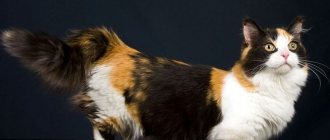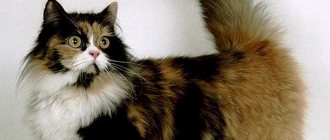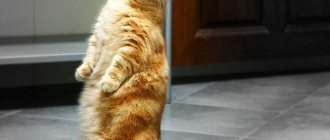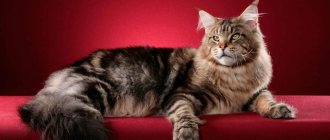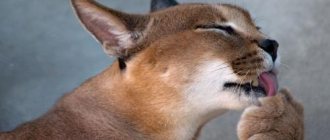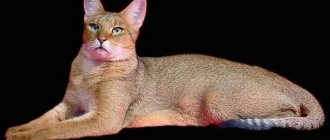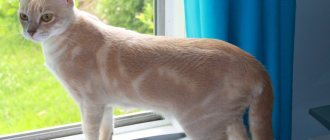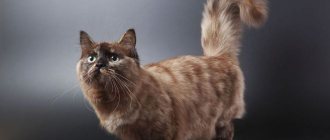April 3034009domestic cats munchkin
The Munchkin cat breed is one of the most unusual. Munchkins are short-legged cats. Because of their short legs, Munchkin cats are often called dachshunds. In this article you will find a description and photo of the Munchkin breed, learn the character of these cats, and also find information about the features of care and maintenance of Munchkin cats.
The origin story of munchkins
Mentions of cats with difficult appearance appeared back in the 30s in Europe.
The main feature was that the hind legs were normal, and the front legs were shortened. Cats appeared in England, Russia, Germany, and the states. Notes about unknown individuals were published in German and American magazines. During the Second World War, such cats disappeared altogether. Munchkins are officially American, but they could also be Russian. Even during World War II, kangaroo cats with shortened front legs were seen in Stalingrad. Sitting on their hind legs, the cats looked very much like a miniature Australian jumper. At one time they were even called “Stalingrad kangaroos”.
Kangaroo cat
More modern mentions have appeared since 1983. The name “Hedgehog” was popular, and to this day, owners of catgnomes can hear this name. This is what music teacher Sandra Hochenedel from Louisiana named her cat. In 1983, a woman found a pregnant cat on the street and thought it was sick or seriously injured. But after the babies were born, Sandra realized that Blackberry was okay. Since several kittens from the litter inherited a strong gene for short legs. The teacher decided to give one of the kittens to her friend Kay LaFrance, who named the baby Toulouse.
One doctor-judge from The International Cat Association became interested in this unusual breed. After research, he proved that this mutation is natural and safe for cats. The genetic dominant mutation turned out to be a spontaneous natural defect. The back and tail remained the same in shape and structure as those of ordinary cats. Shortened legs do not interfere with normal life. The internal organs do not have any defects. Simply put, the species appeared completely by accident as a result of crossing cats with shorter limbs with other domestic cats.
The gene causing the mutation is called the achondroplasia gene, or more precisely, dwarfism with disproportionate limbs.
In 1991, munchkins were presented at the TICA exhibition.
In 1991, munchkins were introduced to the public at the TICA exhibition in Madison Square Garden. At first, many were skeptical about the strange breed, but by 1994 the breed was included in the list of developing ones, in 1995 they received official recognition, and already in 2000, munchkins became truly popular and received the title. In 2001, cats were first brought to Russia.
The breed has received recognition from many associations, such as TICA, AACE, UFO, etc.
Minuet
Proud and beautiful cats
The first kittens were born in 2000. Minuet is the result of crossing Persian cats with Munchkins.
Interestingly, when created, the breed was called “Napoleon”. But in 2015, it was renamed minuet, considering the previous name offensive to the French.
Character
Minuets are phlegmatic, proud cats. Sometimes, a desire to communicate, run around and have fun awakens in them, but this rarely happens. Napoleons are independent and independent cats. Despite their phlegmatic nature, they love to jump and climb to heights.
Health
Despite the love of jumping, it is worth limiting this method of cat movement. Otherwise, problems with the spine cannot be avoided.
Peculiarities
Napoleon cats have a hard time getting along with their own kind. As for children and dogs, representatives of the breed treat them favorably. Only children need to be explained that pets need to be handled with care.
Description of the munchkins' appearance
As you might have guessed, the main feature of the breed is its short legs, which at first glance look smaller than those of ordinary cats. The hind legs are slightly longer than the front ones.
Munchkins can look different depending on the breed the cat was crossed with. For example, ears can be curved if you cross a Munchkin with an American Curl.
Kinkalow - a cross between a Munchkin and an American Curl
Curly-haired munchkins are the result of crossing with LaPerm.
Skookum - munchkin kitten with Laperm
Napoleons (Minuets), which were obtained due to mating with a Persian cat, will have a slightly flattened muzzle.
Munchkin + Persian cat
What can we say about munchkin leopards (Genettas), which are relatives of Savannahs. Just a little piece of art.
Genetta - munchkin
Dimensions and weight of munchkins
Seals are divided into three types based on length: regular, short, and extremely short.
The classic munchkin is a bit like a loaf of bread: the body is wide and round, small but strong. The chest is slightly rounded and the back is slightly arched. The muscular system is well developed. The muzzle is round and proportional to the body.
Munchkin looks like a candy bar
Kittens grow quite quickly, but do not reach large sizes. The height reaches only fifteen centimeters, and the weight reaches from 2 to 4 kilograms. A small tail proportional to the body.
Cats have large, beautifully shaped eyes. The breed does not have a specific eye color.
The coat is found in all types: longhaired, semi-longhaired, shorthaired, hairless. The fur itself is soft and has a medium undercoat.
Popular munchkin colors
The color of the fur can be completely different, depending on the color of the fur of the parents. There are two- and three-color cats. You can find both stripes and spots. There are colors reminiscent of Siamese or Bengals.
Munchkin - Siamese
This is not surprising, since munchkins are crossed with a very different and large number of breeds.
Not so long ago, hairless munchkins appeared, which were the result of crossing with Sphynxes.
Munchkin + Sphynx + Curl
There are also completely black munchkins.
Black munchkin
The rarest colors at the moment are chocolate and marble. They are very actively breeding.
Disqualification criteria
Unfortunately, the breed has some defects and characteristics that are not recognized by the standards.
Signs that some may consider disadvantages:
- Very short or very long nose.
- Strongly protruding chest.
- Paw placement.
- Short body.
- Curly fur.
Cats that have:
- Deafness.
- The claws are amputated.
- There is cryptorchidism (congenital pathology).
Disqualifying signs for the exhibition:
- Hanging croup.
- Strongly concave back.
- Characteristics of other breeds.
Breed standard
Munchkins are cats with short legs, which is their characteristic feature. Their appearance will not allow them to be confused with any other breed. Short legs are a random result of mutation in domestic cats. This body structure does not affect mobility and health at all.
Breed characteristics:
| Head | It has a wedge shape. A round head is a departure from the breed characteristics. The cheekbones are outstanding. The transition from forehead to nose is smooth. |
| Ears | Ears are medium to large in size. The ends are rounded. In semi-long-haired representatives, tassels on the ears are acceptable. |
| Eyes | Medium-sized or large, almond-shaped. The expression of the muzzle is open. Eye color does not depend on coat color. Round eyes are considered a disadvantage. |
| Body | The body is elongated, for which the munchkin is called a dachshund cat. From the shoulders to the tail, the back goes with a slight slope. The chest is round. Well developed muscles. |
| Tail | The tail is not short, but strong. Equal in length to the body. When the animal is in motion, the tail is positioned vertically. |
| Paws | The limbs are short and of equal width along their entire length. The description in the standard allows that the length of the hind legs may be slightly longer than the front legs. The paw pads are rounded. Curvature inward or outward is not allowed. |
The body and head are proportional to each other, so it is a mistake to classify Munches as dwarf breeds. On the contrary, dwarfism is a disqualifying sign at exhibitions. Just like a sagging back and twisted limbs.
Munchkins weight – 2.3 – 4.1 kg. A cat is easy to distinguish from a cat. It is much smaller. Females are so small that they can compete with the Singapura in miniature size.
Munchkins continue to actively grow for up to a year. It then slows down and stops by 18 months.
Short legs do not affect life expectancy in any way. On average, munchkins live 12-16 years. But there are also long-livers. With proper care and properly selected food, animals live up to 20 years.
Munches can be short-haired or semi-long-haired (rare). The former have a plush, stuffed coat, while the latter have straight, smooth, with a good undercoat. Cats with curly hair are automatically eliminated from contenders for championship titles.
The colors are very diverse: with markings, patterns, Siamese style, single-color, bicolor, tricolor.
The most valuable colors:
- Cinnamon is a red-brown or cinnamon color.
- Mink is a Tonkinese color in all varieties with golden moire.
- Sepia – all colors without stripes or moire.
- Ticked tabby is an Abyssinian color with a rippled coat.
Character and habits of munchkins
The breed's character is very docile and friendly. Cats don't know aggression. I can find a common language with both children and other pets.
Munchkins are quite active and curious. They love to play, frolic, run and jump a lot. Of course, due to their peculiarity, they cannot jump high, but a small obstacle or height will not stop them. Very nimble and fast. Watching them quickly move their little paws is a pleasure.
Munchkins love to play and carry things
Cats have a well-developed intellect, they quickly respond to training and follow the example of their environment. From childhood, kittens understand what they can do and what they cannot do. They can carry some things, clothes that are out of place, towels and, for example, make a house out of it. They quickly settle into a new place, walk calmly on a leash and easily endure the road.
Munchkins walk calmly on a leash
One of my favorite activities is to stand on my hind legs with my front legs folded across my chest. They stand in this position for a long time and resemble a mini-kangaroo.
Feeding and caring for munchkins
Munchkins are prone to obesity, which can have a very detrimental effect on their health, so the diet must be selected carefully and wisely.
Munchkins tend to be overweight
The best and simplest option is “super-premium” dry food for a certain age, variety, length of coat, which contains all the necessary substances. If you still decide to feed your cats animal food, then you need to calculate the correct proportion of proteins, fats and carbohydrates. Typically the proportion is 60/30/10% respectively. Be sure to exclude smoked, fatty and sweet foods. Like any domestic animal, cats need to change their water, clean and fresh.
Small kittens are given food 5 times a day, with age the volume is slightly reduced, and adults are fed 2-3 times a day.
Caring for these cats does not require any special procedures. They, on the contrary, unlike many other fluffy ones, love to be brushed. This can be done using a comb with bristles or gloves with a rubber coating. Comb long-haired pets with a furminator and remove any formed tangles.
Munchkins love to be groomed
Every quarter the cats are bathed with a special shampoo. You should regularly clean your eyes and ears using cotton swabs. Trim the claws as they grow.
Don't skip brushing your teeth. This breed is prone to stone formation. The cat must have its own toothpaste and brush. You need to brush your teeth once a month.
All procedures are not very difficult to perform, but if any difficulties arise, you can contact animal salons that are actively developing.
Skookum
Skookums are sometimes confused with lambkins.
No, this is not a scary creature from myths. Skookums are adorable cats with short legs. The breed is young, there are no representatives in Russia. You can buy a kitten in American nurseries, but the price of the baby scares off many - from 2,000 thousand euros. And they are unlikely to sell a good kitten to countries where Skookum breeding is at zero.
The ancestors of the breed are La Perm and Munchkin. The first litter of unusual kittens was received in Washington.
Character
Oh, you won’t find a more curious pet during the day with fire. Skumum needs to know everything that happens in the house. The pet will definitely find out why the owner needs this or that thing. Therefore, it is better to keep expensive things away
Health
Like most short-legged cats, Skookums suffer from spinal problems. Some individuals develop eye diseases.
Peculiarities
Representatives of this breed are completely unpretentious in food. Of course, unpretentiousness does not mean that the animal will gratefully eat table scraps. This means the absence of any diet; Skookums can easily get by with balanced food.
The second nuance of cats is that their fur needs water. In order for the Skookum's fur to remain airy, the pet must be sprayed with water periodically.
Skookums sleep funny, like Pembroke Welsh Corgis. Lying on your stomach with your hind legs spread out like frogs.
Munchkin health
Representatives of this breed have fairly good immunity due to the constantly expanding gene pool.
There is one possible disease that can occur in the breed. This disease is lordosis. It appears either as a congenital disease or acquired, for example as a result of obesity. Lordosis is a very large curvature of the spine that disrupts the structure of the body and puts pressure on the internal organs. As a result of the disease, the functioning of not only the body, but also the respiratory and cardiac systems is disrupted.
To avoid diseases common to all cat breeds, you need to give your cats vaccinations and the necessary procedures in advance. This will not only prevent disease, but will also prolong the life of your pet.
Genet
The most unusual short-legged cat
One day, Shannon Kiley—that’s the name of the breeder of rare and unusual cats—decided to conduct an experiment. The woman often and a lot communicated with people, most of whom complained about the impossibility of having a rare animal at home. For some reason, most people were inclined to keep genets at home. Genetta is a wild, predatory animal, at the same time similar to a cat, ferret and dog.
Mrs. Kylie decided to breed a breed that would combine the beauty of a wild genet and the character of a domestic cat. As a result, after crossing a Bengal cat, a Savannah cat and a Munchkin, pets appeared that were called “Genetta”. The first litter was received in 2006.
Character
A sort of cat-dog. Representatives of the breed are easy to train, love to run, are extremely curious and poke their noses everywhere they can. The most favorite game is to bring the ball to the owner.
Genettas are friendly towards other animals, so they can easily coexist peacefully next to a dog or be the second cat in the house.
Health
Genettes are believed to have good health. But, since the breed is experimental, many features have not yet been studied.
Peculiarities
These cats are extremely sociable and absolutely do not like to be alone. If a genet's owners leave her alone for a long time, the cat's character begins to deteriorate. From a tame and affectionate pet, a genet can turn into an evil creature.
Content Rules
Before getting a munchkin, you need to know some of the nuances of keeping such an unusual cat.
- Because of their curiosity and activity, cats love to make houses for themselves out of everything they come across. Therefore, it is better for yourself to take care of your pet’s habitat in advance, buy a house, maybe even with a scratching post. And, of course, taking into account the small size so that the cat can climb into it. For the same purpose, buy toys for your cat to play with.
Take care of things by size
- Buy a tray with not very high sides for your pet's comfort.
- Play with your pet more often, walk on a leash. Munchkins love walks. But don't let the cat out alone. A low "slung" may seem like a sign of attack in other animals. But catognomics will not be able to cope with a large enemy.
- Maintain a moderate diet to prevent your cat from becoming obese. Try to provide your animal with an active lifestyle.
Nutrition
Unless your munchkin has special nutritional needs as determined by your veterinarian, you can feed him the same food as any other indoor cat. Munchkins are generally the same size as medium-sized cats and should be fed accordingly. Wet food is the best source of nutrition, but it is wise to offer your pet dry food periodically, which is good for his teeth. Do not overfeed your pet or give him too many treats to prevent the development of diabetes and obesity. Always make sure he has clean, fresh water and play with your cat to keep him healthy and active.
Reproduction and lifespan
When breeding a breed, you need to take into account many nuances. You should not engage in independent breeding without proper preparation. You need to be a professional who understands cat genetics.
Short-legged cats come in two types - standard and non-standard. The first ones have short legs, the second ones have long legs. If a kitten receives the gene for short legs from both parents, it will die as an embryo.
Munchkins should not be combined with breeds that have other strong mutation genes, as the offspring will be small and may even be incapacitated.
Munchkin breeding should be done by professionals
All new matings should improve the characteristics of the breed.
Seals reach sexual maturity at about one and a half years, and only then are they allowed to breed. Males can breed more often than females. A munchkin cat should give birth no more than twice a year. There are three or four kittens in a litter.
In three cities of Russia they professionally breed munchkins: Moscow, St. Petersburg and Novosibirsk.
If breeding is carried out by professionals, mating occurs under their supervision and all genetic risks are observed, then the cats will be born healthy and live long enough. On average, the life expectancy of munchkins is 13-16 years.
Interesting facts about munchkins
In addition to short legs, the breed has some other features and interesting facts:
- Despite their short legs, the seals are very active and fast.
- The short paw mutation turned out to be completely spontaneous.
- During the Second World War, the breed was called “Stalingrad Kangaroos” because of its love of sitting on its hind legs, folding its short front legs.
- The smallest cat in the world is Lily. Her height is only 13.5 centimeters. It is not surprising that it was the munchkin who received this title and is included in the Guinness Book of Records.
The smallest cat is the Munchkin cat.
- The breed has a lot of nicknames: dwarf cats, catgnomes, dachshund cats, sausage cats, kangaroo cats and even magpie cats because of their love of carrying all sorts of things.
- The name "munchkin" comes from the characters in Lyman Frank Baum's book The Wizard of Oz. This was the name of the dwarf people from the work.
- Munchkins hardly make any sounds. It is believed that they meow less often than other breeds.
- Cats are very popular even among celebrities. Paris Hilton has two cats of this breed.
Pros and cons of munchkins
Unfortunately, each breed can have both advantages and disadvantages.
Pros:
- Friendly and active.
- They respond well to training.
- Not very picky about food.
- They do not require special care and love to be brushed.
- Quite strong immunity.
- Cute appearance.
Munchkins are active, love to go for walks, are trainable and very cute.
Minuses:
- Munchkins love to carry things.
- Susceptible to bone disease.
- Prone to obesity, as a result, worsening lordosis.
